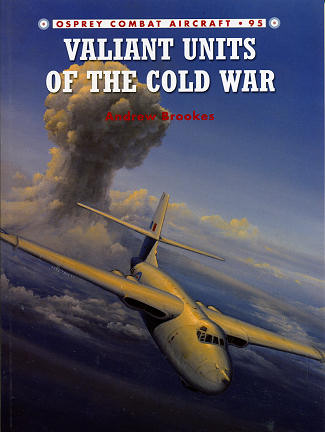 Number
95 in Osprey's Combat Aircraft series is on the Vickers Valiant, the
shortest-lived of Britain's three 'V' bombers. It is also the only one of these
planes that dropped a hydrogen bomb.
Number
95 in Osprey's Combat Aircraft series is on the Vickers Valiant, the
shortest-lived of Britain's three 'V' bombers. It is also the only one of these
planes that dropped a hydrogen bomb. |
Author: |
Andrew Brookes |
|
Publisher/Distributor |
Osprey Publishing |
|
Price |
$22.95 MSRP |
|
Reviewer: |
|
| Notes: |
96 pages, 7¼ x 9¼ inches, softbound ISBN: 1-84908-753-7 |
 Number
95 in Osprey's Combat Aircraft series is on the Vickers Valiant, the
shortest-lived of Britain's three 'V' bombers. It is also the only one of these
planes that dropped a hydrogen bomb.
Number
95 in Osprey's Combat Aircraft series is on the Vickers Valiant, the
shortest-lived of Britain's three 'V' bombers. It is also the only one of these
planes that dropped a hydrogen bomb.
After WWII, the British knew that they would need to have a bomber capable of reaching targets in the Soviet Union and able to carry the then weighty nuclear bombs in their arsenal. So a proposal was placed and four aircraft were chosen. Two were rather radical in design; the Avro Vulcan and Handley Page Victor. More 'standard' was the Short Sperrin and the Vickers Valiant. In fact, the Valiant was not originally in the running but such were the powers of persuasion of the folks at Vickers that it was added to the mix. The Sperrin was a non-contender and after the prototype was built, it spent its years as an engine test bed.
The last in the mix was also the first to be produced. A more conventional looking airframe, Vickers was able to get airframes into service before either of the other two contenders. It was also the slowest, the one with the lower max altitude and the one with the shortest range. However, it was also nearly without vices, easy to fly and was able to get into service years ahead of the others. Thanks to this, the aircraft was able to participate in most of the UK's atomic testing before atmospheric testing was banned in the late 1950s. It was the aircraft that dropped the first British fusion bomb and was able to develop tactics for delivery and escape that were used by the entire V bomber fleet.
Little known is that the Valiant was not only built in the bomber version but also as a recce plane, tanker and ECM aircraft. In fact, the second squadron to form on the Valiant was the recce unit, so much in need of this type of high flying long range aircraft was the RAF. Yes, it had the Canberra, but it was sorely lacking in range.
Eventually, the mission changed from high altitude bombing to low level attacks. This was as much thanks to the improvement in surface to air missiles as anything else. Despite being in service for a mere 10 years or so, the Valiant was grounded pretty much en masse. This was due to the type of aluminum used in the airframe. Unfortunately, with age, the type that was used was prone to cracking and as it was uneconomical to repair the stressed structure, they were scrapped. Why wasn't this caught? Well, at the time they did not know about this issue with the alloy used. Now we do and it is no longer used for stressed areas on aircraft.
Author Andrew Brookes takes a look at the design and development of the Valiant including the build up of various units and the equipment that was used by the aircraft. We also get a good look at its time when it was used to test nuclear bombs in the South Pacific. The changes in mission are also closely followed so we can see how Valiant operations were carried out. Of course there are a goodly number of pilot and crew stories to go along with all of these events. This is very much a part of what makes this such an enticing series. Also included are quite a few full color profiles of Valiants in every camouflage scheme and with every unit that flew the aircraft. The book concludes with a brief synopsis of all the units that flew the aircraft.
In all, I found the book to be a superb read about an aircraft that is often overlooked. Most highly recommended.
October 2012
For more on the complete line of Osprey books, visit www.ospreypublishing.com or contact them at Osprey Direct, PO Box 140, Wellingborough, Northants, NN8 2FA, UK. In the US, it is Osprey Direct at 44-02 23rd St, Suite 219, Long Island City, NY 11101., where you can get a catalogue of available books.
If you would like your product reviewed fairly and quickly, please contact me or see other details in the Note to Contributors.